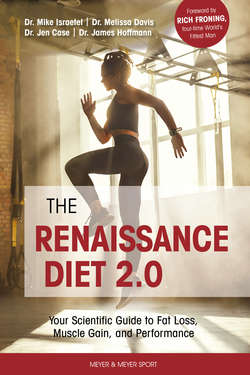Читать книгу The Renaissance Diet 2.0 - Mike Israetel, James Hoffmann - Страница 77
На сайте Литреса книга снята с продажи.
Pre-Training Window
ОглавлениеThe pre-training window refers to the 30 minutes to 4 hours before training begins. During this window, carbohydrate is needed to top off muscle glycogen stores and help regulate blood glucose levels in preparation for the high-energy demands of training. A state where muscle glycogen stores are full has two interesting benefits. The better known of these is to energetically support high-intensity muscular activity. A lesser known benefit is that full muscle glycogen stores directly signal the muscle to become more anabolic, which enhances muscle retention or growth (depending on calorie intake).
Pre-training window meal restrictions include limiting meal size and avoiding slow-digesting foods when the meal is eaten closer to training. Most blood will leave the GI tract during high physical exertion in order to circulate between the working muscles, heart, and lungs. Without blood to pull nutrients out of the intestines, undigested food in the GI tract can lead to discomfort, nausea, or even vomiting. If an individual is too full to perform well after a large meal, training will be impaired, ultimately defeating the purpose of the pre-training meal. Likewise, having insufficient energy for training from fasting all morning can have equivalently detrimental effects.
The size of the pre-training meal and digestion time of its contents should be scaled to the time between this meal and training (figure 4.9). Larger, slower digesting meals can be an option if the pre-training meal comes three to four hours before training. In contrast, a very small amount of quickly digesting protein and carbs (with minimal fat and fiber) should be consumed if one is eating around 30 minutes before training. In the latter case, some intra-workout carbohydrate ingestion may be advisable to prevent sudden changes in blood sugar due to the fast absorbing carbs and their rapid use during training. Maintaining stable blood sugar is preferable for best performances.
Figure 4.9 A. Smaller meals can be eaten closer to training time and still provide sufficient nutrient availability to support training. B. Larger meals should be eaten if the pre-training meal will occur earlier so that there is still sufficient nutrient availability by the time training occurs.
